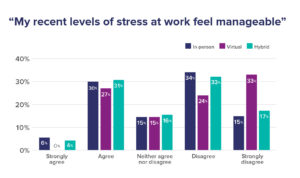New Findings Show Principals Under Pressure
Initial findings of People for Education’s 2020/21 Annual Ontario School Survey (AOSS) show that principals are dealing with an exceptional set of challenges related to running schools during a pandemic.
The survey results include responses from 1173 schools from across Ontario, including 906 in-person, 226 hybrid, and 41 virtual schools.
COVID-19 adds a range of new responsibilities
According to the report, COVID-19 has added a wide range of new responsibilities to principals’ already challenging roles. (see below for other research on principal and teacher responsibilities and well-being) Principals are now responsible for ensuring that new provincial COVID screening and reporting requirements are followed each day, acting as liaisons with local public health units, and implementing new policies connected to COVID-19 including maintaining staff and student cohorts and physical distancing.
In February, principals also became responsible for daily validation of staff and student self-screening in all schools, and weekly reports on asymptomatic testing in 5% of schools per board. (Gov. Memos A & B)
“The physical running of the school has been quite successful despite the current circumstances. However, the staff (myself included) are absolutely exhausted. It feels as though we are expected to function as always with an enormous amount of new (COVID-19) expectations to follow.”
—Principal, in-person elementary, Northern Ontario
Principals report high levels of stress
The majority of principals of virtual schools disagreed with the statement “my recent levels of stress at work feel manageable.” There significant differences in principals’ responses depending on the type of school:

- 57% of principals of virtual schools disagreed or strongly disagreed that their levels of stress felt manageable, compared to 49% of principals of in-person and hybrid schools.
- 36% of principals of in-person schools agreed or strongly agreed that their levels of stress were manageable, compared to 27% of principals of virtual schools.
“Admin and staff need to be better informed about changes – should not come from media releases.”
—Principal, in-person secondary school, Southwestern Ontario
Ranking the issues
To help understand the unique challenges in schools this year, the 2020/21 AOSS asked principals to rank COVID-19-related issues – from most, to least challenging. There were marked differences depending on the type of school:
- Managing student enrolment was ranked #1 or #2 by 72% of principals in virtual school, compared to 15% of principals in hybrid schools.
- Space and distancing was ranked #1 or #2 by 73% of principals in in-person schools, compared to 33% of principals in hybrid schools.
- In-person schools were most likely to rank space and distancing and coordinating staffing in the top two, compared to virtual schools, where principals were most likely to rank managing student enrolment and coordinating staffing in the top two.
“As an administrator, the demands are truly not manageable for one person. There are many additional tasks that we have been asked to complete pertaining to PPE distribution, pivoting when cleaning processes change, re-timetabling the school (3 times to date) when numbers shift due to model changes, and filling vacancies.”
—Principal, in-person elementary school, GTA
| Percentage of principals ranking the issue #1 or #2 | |||
|---|---|---|---|
| In-person | Hybrid | Virtual | |
| Space and physical distancing | 73% | 33% | n/a |
| Coordinating staffing | 63% | 48% | 43% |
| Health and safety | 20% | 17% | n/a |
| Ventilation | 12% | 11% | n/a |
| Managing student enrolement | n/a | 15% | 72% |
Principals’ recommendations for change
The survey asked principals to name one thing that could better support their well-being during this time. Their recommendations can be divided into four overarching categories:
- Increased and available staff including vice-principals, supply teachers, and support staff
- A reduction in workload including no new initiatives, cancelling non-essential paperwork, more planning time
- Clearer and more consistent communication, including receiving information before it is announced publicly and with enough time to implement changes
- Recognition of the impact of COVID-19 on the role of principals, and including principals in decision-making
“Smaller class sizes. It is impossible to keep students socially distanced. I am constantly the COVID police. They are fairly good at keeping their masks on during instructional times, but it seems pointless when they take their masks off to eat for 20 minutes each day right beside each other. I have classes sizes of 24-27 students and can’t possibly space them out to eat.”
—Principal, in-person elementary school, Northern Ontario
People for Education’s recommendations
Along with the report, People for Education has submitted a letter to the Minister and the Deputy Minister calling for establishment of an Education Advisory Task Force with all key stakeholders from education and health represented. People for Education, along with the other signatories, says that bringing together an advisory table that meets regularly, and that informs policy before it is implemented, would help to ensure clearer more consistent and coherent policy during and after the COVID-19 crisis.
The organization also recommends that the Education Advisory Task Force be consulted on funding for 2020/21, to ensure there are sufficient resources, programs, and staff in schools to respond effectively to a range of impacts resulting from COVID-19.
Read the research on principals’ roles, the impact of COVID-19 and teacher mental health
- Pollock & Wang (2020)
- CAMH COVID-19 Policy Advice (2020)
- Canada Teachers’ Federation Teacher Mental Health Check-in Survey (2020)
- TDSB Return to School Surveys: Parents, Students, & Staff (2020)
